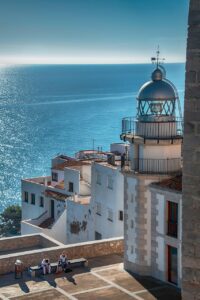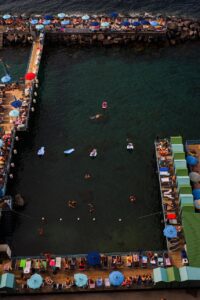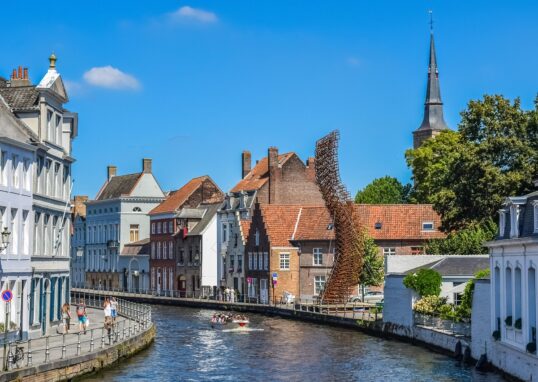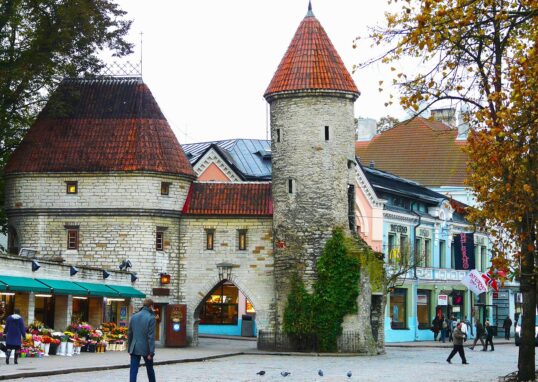
The Costiera Amalfitana – Italy’s Dramatic Coastal Treasure
The Amalfi Coast is one of Italy’s most magical places, lying in the Campania region, along the southern side of the Sorrento Peninsula. The coastline runs from about Positano to Vietri sul Mare, facing the Tyrrhenian Sea in the Gulf of Salerno. Here the mountains rise steeply from the sea. Terraced vineyards and lemon groves cling to the hillsides. Tiny villages nestle in cliffs above bright blue water. Because of its beauty and cultural importance, the entire area was inscribed by UNESCO as a World Heritage Site in 1997. In this article, we detail its geography, history, culture, towns and villages, nature, food, visitor tips, and finally, places that surround it.
Geography and Landscape
First of all, the landscape is dramatic. The coast is extremely steep: mountains drop almost vertically into the sea. The main mountain range is the Monti Lattari; it forms a natural spine behind the coast. It measures approximately 11,231 hectares over the area of 15 municipalities. Due to the steep landscape, the people developed terraces along its slope. In those, they cultivated citrus trees, olives, and vines. There are many small bays, rocky cliffs, beaches and steep roads. The vegetation is mixed: Mediterranean shrubs, lemon groves, vineyards. The sea is deep and clear. Along the water you will find colourful villages. From above you will see stunning views of blue sea, green hills and cliffs.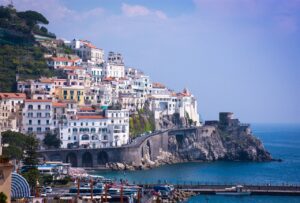
A Brief History
Historically, the Amalfi Coast goes way back. Remains from the Mesolithic and Paleolithic ages have been found around places like Positano. During the Roman era, many villas were built along the coast and in Minori, for instance. Everything Everywhere+1 After the fall of the Roman Empire, the area belonged to the Byzantine sphere and later developed its own identity. In the 9th to 11th centuries, Amalfi became the seat of the Duchy of Amalfi (Amalfi Republic), a maritime republic which traded across the Mediterranean. Over the centuries, the coast has developed many watch-towers and defense structures against pirates and invaders.
Towns and Villages of the Coast
Let’s take a glimpse at some of the most beautiful coastal places.
Positano
Positano is perhaps the most iconic village on the Amalfi Coast. It’s filled with pastel-coloured houses that climb the hillside. It has narrow stairways, little shops, beach cafés, and views that take your breath away. Many artists were inspired by Positano.
Amalfi
The town of Amalfi gives the coast its name. It has a rich history. The Cathedral of Saint Andrew (Duomo di Amalfi) occupies a large square. It combines Arabic‐Norman, Romanesque and Baroque styles. The town was once a powerful maritime republic. Inside the museum you can find the Tabula Amalphitana, the old maritime law code.
Ravello
High above the sea is Ravello. It is smaller and quieter than Positano or Amalfi. It is known for its gardens, villas and historic charm. Villa Rufolo and Villa Cimbrone are must-see places. The terrace at Villa Cimbrone offers stunning views.
Vietri sul Mare
At the eastern end of the coast, Vietri sul Mare is known for its ceramics. Colourful painted pottery is part of the tradition. It’s a bit more local and less crowded.
Other Villages
Other charming communes include Atrani (one of Italy’s smallest towns), Furore (with its fjord-like harbour), Praiano, Conca dei Marini, and Minori. Each has its own character.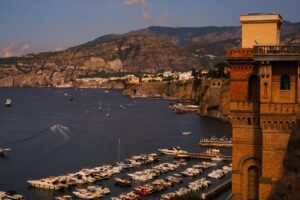
Nature, Gardens and Viewpoints
The coast offers not only picturesque towns but excellent nature. The terraced slopes provide a dramatic “man‐made” natural scene, while the changes in altitude create micro-climates and diverse plant life. The road SS163 follows the coastline and offers many viewpoints. Every bend in the road reveals another cliff and sea panorama. And the road itself is part of the fun. There are hiking trails such as the famous Sentiero degli Dei (Path of the Gods) that offer walking above the villages on ridges with outstanding views. The coast also has cultivated landscapes: lemon groves, vineyards and olive trees. The lemon of Amalfi (limone di Amalfi) is famous and protected by I.G.P. status. The sea near the coast is blue and deep. You can take boat trips, admire hidden coves, and discover caves and grottos. Some parts of the marine bed are protected too.
Culture, Food & Craft Traditions
Culture here is rich: the villages show architecture blending eastern and western influences, Arabic-Norman style. The traditions of the coast also include paper-making, textiles, ceramics, and lemon cultivation. Food is a treat. Fresh fish, seafood, local pasta, lemons and olive oil are key ingredients. Try pasta scialatielli, seafood risotto, anchovy dishes from Cetara. Lemon-based desserts and limoncello are other local specialities.
- Crafts: Vietri’s ceramics, handmade paper in Amalfi, lemon products, and local wines from the terraces. These can be purchased by the tourists as local souvenirs.
- Traditional music and events: There are local religious festivals, musical events in Ravello (Ravello Festival), and simply the daily ritual life of the coastal towns with cafés and evening promenades.

Visiting Tips & Practical Information
When to visit: Spring (April–June) and autumn (September–October) offer mild weather and fewer crowds. Summer is peak tourist time and can be crowded. According to recent travel advice, the off-season provides a more real atmosphere.
- Getting there: Nearest major airports are Naples (Napoli) and Salerno. From Naples you can travel by car, bus, ferry or train. On the coast the main road SS163 connects the villages. Ferries and hydrofoils connect from Sorrento, Salerno, Amalfi. Getting there Transport tips The roads are narrow and twisting. Parking is difficult in summer. Consider using public transport.
- Stay: Base yourself in a village that suits your style: Positano for glamour, Amalfi for history, Ravello for quiet. Book well ahead in high season.
- What to pack: Good walking shoes (villages often involve steps), swimwear, sun protection, light layers (it can be cooler up in the hills), camera.
- Respect local space: Many villages have narrow streets and limited access. Avoid blocking traffic, keep noise down in quiet zones at night.
Surrounding Places in Detail
Costiera Amalfitana, commonly known as the Amalfi Coast, is one of the most beautiful coasts in Italy. It lies in the region of Campania, stretching along the southern edge of the Sorrentine Peninsula.
Sorrento
Sorrento is on the northern end of the Amalfi Coast, the most famous gateway in the area. This town is high above the Bay of Naples and enjoys breathtaking views from Mount Vesuvius down to Capri Island. The narrow lanes of the old town in Sorrento are home to lemon shops, cafes, and boutiques. The heart of the city, the Piazza Tasso, is very vibrant, full of life both day and night. In addition, the Cathedral of Sorrento and the Museo Correale di Terranova reflect the rich cultural heritage that has been preserved in this city.
Positano
Positano is considered one of the treasures of the Amalfi Coast: the town, which faces directly onto the sea, develops vertically with multicolored houses, flower-covered balconies, and stairways. It has an essentially romantic atmosphere and attracts visitors from all over the world. During sunset, Positano turns gold, and the entire coastline glows. It is also a starting point for boat trips to nearby islands and hidden beaches.
Amalfi
Amalfi gives the name to the entire coastline. It was once a powerful maritime republic in the Middle Ages. Nowadays, history, culture, and sea life blend together marvelously. The Amalfi Cathedral, Duomo di Sant’Andrea, majestically faces the main square, preceded by an impressive staircase, and is the manifestation of Arab-Norman architecture. Inside, this cathedral tells the story of Saint Andrew, the city’s patron saint, through golden mosaics and relics. One can also visit the Paper Museum that preserves the old tradition of hand-made paper. Amalfi’s lemon gardens and nearby grottos further enhance its appeal.
Ravello
Ravello sits high above the coast, offering some of the best views in Italy. It’s quieter compared with Positano and Amalfi, and hence, a very peaceful retreat. This town is highly famous for its gardens and villas. The Villa Cimbrone and the Villa Rufolo are some of the major attractions. The Villa Cimbrone is renowned for its Terrace of Infinity that presents great views of the coastline. In the Villa Rufolo, the composer Richard Wagner took inspiration for his opera Parsifal. Ravello hosts several music festivals, particularly in summer, with artists performing in open-air settings looking out to the sea.
Praiano
Praiano is a small fishing village nestled between Amalfi and Positano, offering a more local experience. It is less crowded but equally beautiful. The colored tile-domed Church of San Gennaro stands out. Praiano is also known for its sunsets, considered among the best on the Amalfi Coast. Visitors also like walking trails that connect the town with other coastal towns, especially the Path of the Gods or Sentiero degli Dei. It also provides quaint restaurants with seafood and a variety of wines, truly a hidden treasure.
Vietri sul Mare
Vietri sul Mare is officially the eastern entrance to the Amalfi Coast, and it is famous for its ceramics decorating almost every wall and shop in town. Bright blue, yellow, and green tiles make the streets come alive. Some of the highlights include the Church of St. John the Baptist, with its tiled dome in shades of magenta, turquoise, and yellow. The Ceramic Museum displays this craftsmanship from over the centuries. Generally speaking, compared to Amalfi and Positano’s rocky beaches, Vietri’s are wide and sandy-a great place to spend a day at the beach.
Minori and Maiori
These two towns are among the most laid-back and boast a very family-oriented atmosphere. The beautiful town of Maiori also boasts one of the longest beaches along the coast, perfect for swimming and sunbathing, with its promenade lined with cafes and restaurants. Equally charming, but much smaller in size, is Minori. It’s famous for the Roman Villa dating back to the first century AD. Visitors can also try the pastries by Sal De Riso, one of Italy’s most famous pastry chefs.
Atrani
One of the smallest towns in Italy, Atrani is situated next to Amalfi. It’s a picture-postcard town with its pastel-colored houses, narrow lanes, and arched passageways. The main square, Piazza Umberto I, is a quiet spot to sit and drink coffee or eat gelato. Atrani retains its genuine, local character and does not feel touristy, which gives one the feeling of true Italian village life.
Furore
The most famous thing about Furore is the Fjord of Furore, a narrow inlet among high cliffs, with a small beach and bridge. This unique natural feature makes it one of the most photographed spots along the coast. The village itself is spread along the cliffs, and murals have been painted on the houses. It is often called the “painted village.” Furore is also home to a number of vineyards and olive groves producing local wines and oils.
Salerno
Just beyond Vietri sul Mare lies Salerno, a larger city and the main gateway to the Amalfi Coast. Salerno boasts a historic center, a beautiful promenade, and excellent transport connections. Salerno Cathedral is dedicated to St Matthew and has impressive forms with medieval and baroque elements. Lungomare Trieste is a street right on the sea, and the walk along this is particularly pleasant when the sun is setting. Salerno is perfect if you want to catch ferries, explore the nearby ruins of Paestum, or head north to Naples.
Capri
Although Capri is technically an island, many Amalfi Coast itineraries include a visit here. It’s available by ferry from Sorrento or Amalfi. Capri represents a place where you can find luxury shops, blue waters, and dramatic cliffs. The great cavern, the Blue Grotto, is a sea cave where the tides cast a glowing light of blue inside. Another famous landmark is the Faraglioni Rocks, rising out of the sea. Capri has three towns: Anacapri and Capri Town boast quaint streets, elegant cafes, and beautiful gardens; the Gardens of Augustus offer breathtaking views of the coastline.
Pompeii and Mount Vesuvius
A short ride from the Amalfi Coast, Pompeii is an ancient Roman city buried when Mount Vesuvius erupted in AD 79. Ruins, temples, and homes remain so well-preserved today that guests can walk through them. Nearby, Mount Vesuvius still looms over the Bay of Naples. The adventurous traveler can hike up to the crater for panoramic views. These sites add a deep historical dimension to any visit to the Amalfi region.
Why Visit the Amalfi Coast?
So, why should you go? The main reasons are:
- Scenic Beauty: mountains and sea, villages clinging to cliffs, emerald water, and lemon groves.
- Cultural Depth: The history of the Amalfi Republic, the architecture, craft traditions, narrow lanes, and old churches.
- Variety of Experience: You can relax on the beach, hike in the mountains, explore villages, enjoy gourmet food, and drive a winding coastal road.
- Original landscape: terraces, lemon trees, vineyards, and old villages contribute to a sense of place.

Challenges and Considerations
However, it is also good to know some challenges:
- Crowds: In high summer, many places are swarmed with tourists, as the locals will tell you.
- Getting Around: The coastal road is narrow and twisty. Parking is limited and often pricey.
- Cost: Because of its popularity, lodging and dining can be expensive. Staying in smaller villages or off-season helps.
- Preservation: The landscape is fragile. Terraces need maintenance, and heavy tourism adds pressure. There are laws and protections in place in the area.
Sample Itinerary (3-Day Visit)
Day 1: Arrival in the town of Amalfi. Stroll around the Duomo, visit the Cloister, explore the old town. Have lunch along the sea. In the afternoon, take a boat to Conca dei Marini and visit the Emerald Grotto. Evening at sunset in Amalfi.
Day 2: Morning, drive or take a bus to Positano. Climb the stairs from the beach up into the town. Have lunch in Positano, overlooking the sea. Afternoon relaxation on the beach or take a hike on the Sentiero degli Dei. Evening: back to Amalfi or choose Ravello for dinner in a quieter setting.
Day 3: Head up to Ravello. Visit Villa Rufolo and Villa Cimbrone for the gardens and views. Lunch in Ravello. Afternoon drive through the interior villages to Tramonti or Scala for a more peaceful rural afternoon. Evening return to the coast for dinner with lemon-tree views.
Conclusion
The Amalfi Coast is one of those places where nature and human effort seem to come together in the most beautiful harmony. The cliffs, the sea, the terraces, villages, and their history all combine into a landscape that is almost magical. Whether you are looking for romance, relaxation, adventure, culture, or just beauty, this coast offers all that. In the words of those who have experienced it: it is “a balcony over the blue sea” and a “living painting”. So pack your bags, bring comfortable shoes, and set off for Italy’s Amalfi Coast. Walk the lanes, taste the limoncello, watch the sunset, and feel the pure joy of “la dolce vita”.

